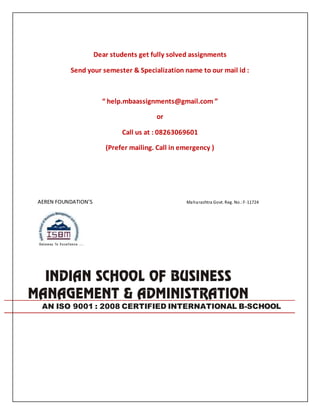
General management s
- 1. Dear students get fully solved assignments Send your semester & Specialization name to our mail id : “ help.mbaassignments@gmail.com ” or Call us at : 08263069601 (Prefer mailing. Call in emergency ) AEREN FOUNDATION’S Maharashtra Govt. Reg. No.: F-11724 AN ISO 9001 : 2008 CERTIFIED INTERNATIONAL B-SCHOOL
- 2. SUBJECT: General Management Q.1 What is Input & Output model? Answer: - An input–output model is a quantitative economic technique that represents the interdependencies between different branches of a national economy or different regional economies.Wassily Leontief (1905–1999) is credited with developing this type of analysis and took the Nobel Prize in Economics for his development of this model. The International Input-Output Association is dedicated to advancing knowledge in the field of input– output study, which includes "improvements in basic data, theoretical insights and modelling, and applications, both traditional and novel, of input-output Q.2 Describe some major kinds of strategies/policies & the hierarchy of strategies? Answer: - The ‘hierarchical strategy’ advocated here involves a combination of group letter writing and face-to-face dialogue and learning support, focusing on one major local organization or branch. The aim is to inform and raise the understanding of the people at the top of hierarchies, eventually seeking to influence the president or prime minister of a nation. An individual, but preferably a small local group attempts to influence the personnel in a significant and relevant local organization. Retired people may be offer substantial effort here. Getting to the top can achieved by letter writing to obtain appointments with relatively high level staff, offering learning support on climate change, and trying then to 3. What do you mean by reengineering organization & Explain key aspects? Answer:- Reengineering an organization is simply the process of reviewing all the different levels of an organization’s way of doing business and considering how to improve things. The goals of reengineering include increased company profits, improved competitive advantage in the marketplace and enhanced public image. Reengineering requires an organization to look closely at its strengths and weaknesses, ask difficult questions where necessary and make changes for the better of the organization. The idea of reengineering an organization is 4. What is departmentation & Types of departmentation? Answer:- Departmentation means division of work into smaller units and their re-grouping into bigger units (departments) on the basis of similarity of features. Each department is headed by a person known as departmental manager. Types of Departmentation
- 3. Functions, e.g., sales, production, personnel, planning, transport, etc. Products, e.g., air-conditioners, accounting machines, electronic calculators, etc. Territory, region, or geographical area, e.g., Northern Railway, Western Railway, N.E. Railway, etc. 5. Distinguish strength of appraisal against verifiable objectives? Answer: - The strengths of appraising against accomplishment of objectives are almost the same as those of managing by objectives. Both are part of the same process, basic to effective managing and are means of improving the quality of managing. In the area of appraising, there are special and important strengths. Appraising on the basis of performance against verifiable has the great advantage of being operational. Appraisals are not apart from the job that mangers do but are a review of what they actually did as managers. There are always questions of how well a person did; of whether goals were missed or accomplished, and for what reasons; and of how much in the way of goal attainment should be expected. But information about what a person has done, 6. Explain Maslow hierarchy of needs theory? Answer:- Maslow's hierarchy of needs is a theory in psychology proposed by Abraham Maslow in his 1943 paper "A Theory of Human Motivation" in Psychological Review.[2] Maslow subsequently extended the idea to include his observations of humans' innate curiosity. His theories parallel many other theories of human developmental psychology, some of which focus on describing the stages of growth in humans. Maslow used the terms Physiological, Safety, Belongingness and Love, Esteem, Self- Actualization and Self-Transcendence needs to 7. Define Leadership with examples? Answer:- Define leadership is just the first step for someone who how wants to be a standout leader. So, what is leadership? Leadership is when an individual chooses to be the one in charge, someone who can provide answers and not be afraid to ruffle a few feathers. They are willing to travel down the road that others fear. A good leader is not scared off and is willing to make tough decisions during tough situations. 1. How Southwest Handled 9/11 8. Explain communication flow in the organization? Answer: - In an organization, communication flows in 5 main directions- Downward Upward
- 4. Lateral Diagonal External 1. Downward Flow of Communication: Communication that flows from a higher level in an organization to a lower level is a downward communication. In other words, communication from superiors to subordinates in a chain of command is a downward Dear students get fully solved assignments Send your semester & Specialization name to our mail id : “ help.mbaassignments@gmail.com ” or Call us at : 08263069601 (Prefer mailing. Call in emergency ) .
